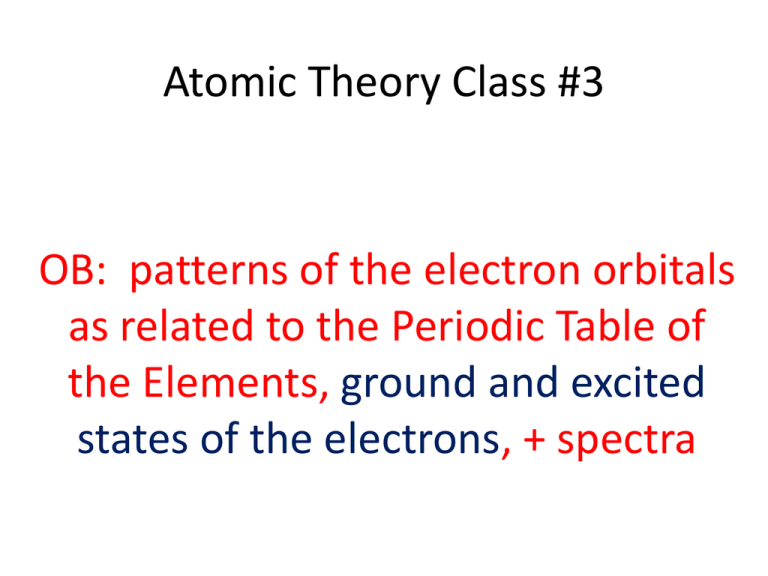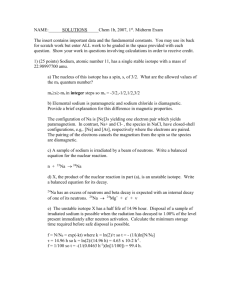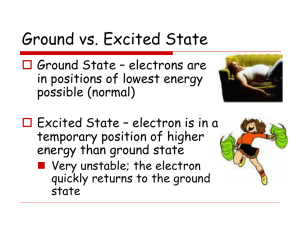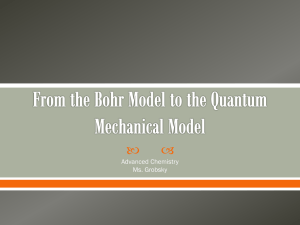Atomic Theory Class #3
advertisement

Atomic Theory Class #3 OB: patterns of the electron orbitals as related to the Periodic Table of the Elements, ground and excited states of the electrons, + spectra Using your white periodic tables, write out the electron configurations of the following: Group 1 Group 2 Group 15 Group 16 Group 17 Group 18 lithium beryllium nitrogen oxygen fluorine neon sodium magnesium phosphorous sulfur chlorine argon rubidium strontium antimony tellurium iodine Xenon Using your white periodic tables, write out the electron configurations of the following: Group 1 Group 2 Group 15 Group 16 Group 17 Group 18 lithium beryllium nitrogen oxygen fluorine neon 2-1 2-2 2-5 2-6 2-7 2-8 Using your white periodic tables, write out the electron configurations of the following: Group 1 Group 2 Group 15 Group 16 Group 17 Group 18 lithium beryllium nitrogen oxygen fluorine neon 2-1 2-2 2-5 2-6 2-7 2-8 sodium magnesium phosphorous sulfur chlorine argon 2-8-1 2-8-2 2-8-5 2-8-6 2-8-7 2-8-8 Using your white periodic tables, write out the electron configurations of the following: Group 1 Group 2 Group 15 Group 16 Group 17 Group 18 lithium beryllium nitrogen oxygen fluorine neon 2-1 2-2 2-5 2-6 2-7 2-8 sodium magnesium phosphorous sulfur chlorine argon 2-8-1 2-8-2 2-8-5 2-8-6 2-8-7 2-8-8 rubidium strontium antimony tellurium iodine xenon 2-8-18-8-1 2-8-18-8-2 2-8-18-18-5 2-8-18-18-6 2-8-18-18-7 2-8-18-18-8 The 1st orbital holds up to 2 electrons The 2nd orbital holds up to 8 electrons While the 3rd orbital holds up to 8 or 18 electrons, and the 4th orbital holds up to 18 or 32 electrons All electron orbitals on the periodic table are in the LOWEST ENERGY state, also called the GROUND STATE. Atoms + their electrons can get energized, and they can get excited. ground state A possible excited state lithium lithium 2-1 sodium sodium 2-8-1 potassium potassium 2-8-8-1 rubidium 2-8-18-8-1 rubidium ground state A possible excited state lithium lithium 2-1 sodium 1-2 sodium 2-8-1 potassium 2-7-2 potassium 2-8-8-1 2-8-7-2 rubidium rubidium 2-8-18-8-1 2-8-18-7-2 Ground + Excited State electron configurations have the SAME NUMBER OF ELECTRONS, they are just in DIFFERENT PLACES For example… Sodium in ground state is 2-8-1 electron configuration Possible excited states include: 1-8-2 2-7-2 1-7-3 2-6-3 Which ones are possible? In our class that question is way to hard to answer. Let’s stick to simple excited states. No excited state that you can imagine would be wrong, because “what is possible” is outside the scope of this course, and I don’t really know all the answers anyway. You won’t be “wrong” by choosing 1-5-7, but let’s be calm: that’s way funkier than the simple 2-7-2 configuration. You know what this is? How do these electrons get excited? Energy can be added into atoms, by heating, electricity, radiation, etc. A unique amount of energy is required to move an electron in any atom or compound. Each atom, or compound, has a unique set up of protons and electrons in orbitals. Different atoms with the same number of orbitals (say sodium and magnesium, 3 orbitals each) have different numbers of protons “pulling” on the electrons. To make one Na e― jump from the 2nd 3rd orbital is a different, unique amount of energy than the Mg atom, because of different number of protons in their nucleus. Atom Number of protons in Electrons living nucleus with + in these orbitals charge pulling on the electrons Sodium Na 11 protons 2-8-1 Magnesium Mg 12 protons 2-8-2 To excite an electron in the second orbital into the third will take different amounts of energy because of the different arrangements of protons and electron in different atoms. A unique amount of energy into the atom, to excite the electrons is required for each electron of each atom or compound. When this unstable situation resolves itself (quickly usually), the unique amount of energy is released. No matter how the energy was added in, most of the energy coming out is emitted as visible light. Each unique amount of energy given off is visible as different colors, which we can see with our eyes. And if we wear refractive lenses, we can se it even better! Energy In, HEAT for example 2 Electrons in an atom or compound, 1 ground state Electrons in an atom or compound, 3 excited state 4 4 Energy Out 1. 2. 3. 4. Matter is in the ground state normally Energy is inserted, here by heating The atoms or atoms in compounds become excited by the gained energy The electrons are unstable in the excited state, so they return to the ground state, giving off that energy they previously absorbed, as visible – colorful light (spectra) Each atom has a mixture of light given off that we see as one color with our eyes. The mixture can be broken apart by refractive lenses. Neon gas, when excited gives off orange light to the eyes. If we look at this with a refractive lens, this is what we will see (the actual colors that mix, to form one color for our eyes. We will see spectra in the ELECTRONS lab, next week. Each spectra is unique, like a fingerprint for each atom, and for each compound. Spectra can be used to determine what unknowns you may have in your hand, or may exist on a distant planet (using a telescope). Be psyched. Understanding this all goes to Niels Bohr, who was quite a guy. Read the Atomic Theory Diary Atomic HW # 1 due Thursday










